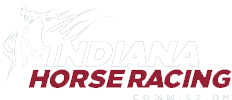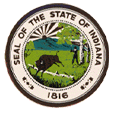Governor of the State of Indiana
Room 206, The Statehouse
Indianapolis, IN 46204
Dear Governor O'Bannon:
The pari-mutuel horse racing industry positioned itself for rapid expansion in 2001. After years of struggle and futility, the Commission approved a permit for a second track in Indiana. This time, in contrast to failed financing efforts in 1994-95, all evidence points to the reality of another racing venue for Indiana horsemen. Indianapolis Downs is expected to open in Shelby County in December 2002.
As in the past, the Commission continues to focus its energies on diligently regulating the pari-mutuel industry. The results of our regulatory efforts, along with statistics of interest, are highlighted in this report.
As the new chairman, I look forward to working with my fellow commissioners to continue to maintain our strong regulatory presence. I am confident that we will continue to grow and further strengthen this unique and important industry.
I am grateful to have the opportunity to serve you, the public and all the fine people in Indiana's horse racing industry.
Respectfully submitted,
Richard "Pete" Beck, Chairman
Indiana Horse Racing Commission
Table Of Contents
- Commission and Staff
- Year in Review
- Live Racing at Hoosier Park
- Distribution of the Wagering Dollar
- State Revenues
- Total In-State Handle
- Breakdown of Handle by Breed and Type
- Breakdown of Handle by Location
- Simulcast Handle - Hoosier Park as Host Track
- Simulcast Handle - Hoosier Park as Receiving Track
- Purses Earned by Type
- Purses Paid
- Occupational Licensing
- Equine Drug Testing
- Human Drug Testing
- Standardbred Breed Development Program
- Thoroughbred Breed Development Program
- Blood Gas Analysis Program
- Riverboat Revenue
- 2002 Calendar of Live Race Dates
Indiana Horse Racing Commission
Commissioners
| Nicolas F. Stein, Sr. | Chairman * (2004) |
| Tim Sams | Vice-Chairman * (2002) |
| Janet Bozzelli | Secretary * (2005) |
| Richard "Pete" Beck | Member * (2005) |
| Ed Martin, Jr. | Member * (2003) |
* Term expires September 1st of year indicated. | |
Staff
| Joe Gorajec | Executive Director |
| Deena Pitman | Assistant Executive Director |
| Robert Smith | Director of Security |
| Wendi Samuelson-Dull | Controller |
| Jessica Larkins | Director of Standardbred Racing |
| Jacki Brown | Thoroughbred & Quarter Horse Breed Development Director |
| Shirley Murphy | Licensing Supervisor |
| Ron Adams | Investigator |
To further assist the Commission with its regulatory responsibilities, the following individuals provided professional or technical service at Hoosier Park during the 2001 racing season.
| Standardbred Judges | Thoroughbred Stewards | |
| Timothy Schmitz, Presiding Judge | Gary Wilfert, Senior State Steward | |
| William Perkins, Associate Judge | Mike Manganelo, Associate Steward | |
| Richard Williams, Associate Judge | Jim Higginbottom, Associate Steward | |
| Commission Veterinarian | Veterinary Technicians | |
| David Younts, D.V.M. | Stephanie Adams | |
| Claudia Shaff | ||
| Marci Shaff | ||
| Racing Inspectors | Thoroughbred Breed Development | |
| Paul Clark | Advisory Committee | |
| Karla Vaughn | Mari Hulman George | |
| Jake Fredrick | ||
| Rich Richey | ||
| Standardbred Breed Development | ||
| Advisory Committee | Standardbred Advisory Board | |
| Henry B. Blackwell, II | Richard Link | Michael Thompson |
| Ernest M. Gaskin | Vic Losure | David White |
| Nat Hill, IV | Nancy Sabatini | Gary Wilcox |
| Jessica Larkins, ExOfficio Member | ||
Year In Review
May
- On May 6th harness driving superstar Luc Ouellette kicks off the Luc Ouellette Challenge during the Harness Horse Youth Foundation's (HHYF) 25th Anniversary Jubilee at Hoosier Park. Ouellette donates a portion of his winnings during the month of May to the HHYF, which is based in Carmel, Indiana. Ouellette wins four races during the night's card before returning to his home base of The Meadowlands. More than $3,500 is raised during the night.
- On May 30th the Commission, on a 4-0 vote, approves a permit to Indianapolis Downs to construct and conduct live pari-mutuel racing in Shelby County. The permit contemplates a harness meet at the new facility to open on or before December 6, 2002.
- On May 7th Don Irvine, Jr. wins his 424th race at Hoosier Park making him the track's all-time leading driver.
August
- Highlighted by the $500,000 Hoosier Cup, Hoosier Park presents the richest night in Indiana horse racing history with its Million Dollar Supercard Saturday, August 18. In addition to the Hoosier Cup, which is won by harness super star Real Desire, Hoosier Park cards races for $114,800, $113,500, $100,000, $80,800, and $79,500. Total purses for the night amounts to $1,018,000.
- Don Irvine, Jr. captures the driving title with 194 wins. John Lee, who saddens the harness industry with his death at age 54 on November 12, 2001, led all trainers with 61 wins.
October
- On October 6th Robby Albarado scores his second Indiana Derby victory aboard Orientate. Trained by D. Wayne Lukas, Orientate pays $32.60 to win in front of a crowd of 6,337.
November
- The American Graded Stakes Committee announces the addition of the Indiana Derby to the list of Grade III events for 2002.
- Fans across the country wager $2,107,487 Friday, November 9 to mark the first time the sale of Hoosier Park's live racing signal eclipses the $2 million mark. Out of 70 nights of racing, the track pulls in 47 $1 million-plus nights in handle for signal sale. Of those 47 nights, nine are in excess of $1.5 million.
- At its November 27, 2001 meeting the Commission lifts the remaining three years of a four year sanction against Centaur, Inc. enabling them to acquire an additional 25% interest in Hoosier Park, LLP.
December
- Terry Thompson earns the riding title while setting Hoosier Park's single season record with 122 wins. Trainer Stanley Roberts also sets a single season record by saddling 42 winners.
Live Racing At Hoosier Park
Standardbred
| Number of Dates | 123 |
| Total Handle | $5,113,260 |
| Average Daily Handle | $41,571 |
| Total Attendance * | 94,719 |
| Average Daily Attendance | 770 |
Thoroughbred
| Number of Dates | 70 |
| Total Handle | $4,610,807 |
| Average Daily Handle | $ 65,869 |
| Total Attendance | 66,812 |
| Average Daily Attendance | 954 |
Combined Standardbred and Thoroughbred
| Number of Dates | 193 |
| Total Handle | $9,724,067 |
| Average Daily Handle | $50,384 |
| Total Attendance * | 161,531 |
| Average Daily Attendance | 836 |
* Corrected May 2002 from printed version
The statistics above represent attendance and handle at Hoosier Park on live racing only. Thoroughbred handle includes $154,461 wagered on Quarter Horse races. Additional wagering on Hoosier Park's live racing at Indiana OTB's is as follows - Standardbred ($2,246,531), Thoroughbred ($2,126,398) totaling ($4,372,929).
Distribution of the Wagering Dollar
The following is a breakdown of the distribution of all monies wagered at Hoosier Park and its satellite facilities:
| Returned to Bettors | $118,083,159.00 |
| Track Share | 18,573,774.00 |
| Purses Earned | 7,757,490.00 |
| Pari-Mutuel Tax | 4,116,927.00 |
| Breakage | 786,085.00 |
| Total Handle | $149,317,405.00 |
State Revenues
The following are the direct state revenues collected in accordance with the pari-mutuel statute IC 4-31:
| Pari-Mutuel Tax | $4,116,927.00 |
| Track Reimbursement for Officials | 325,362.00 |
| Admission Tax | 16,484.00 |
| Fines and Civil Penalties Paid | 23,650.00 |
| Track Permit and License Fees | 13,000.00 |
| Total Revenue | $4,495,423.00 |
The direct revenue received by the State of Indiana exceeded the cost of regulation. Indiana Horse Racing Commission expenditures for calendar year 2001 were $1,256,865.84.
Total In-State Handle
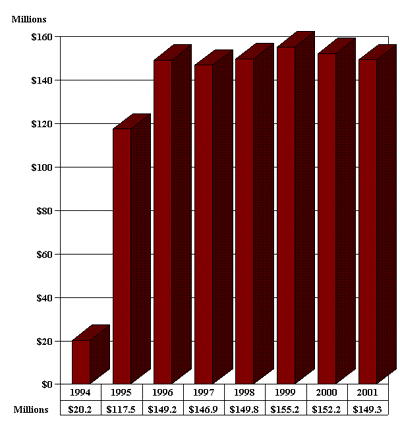
Breakdown of Handle by Breed and Type
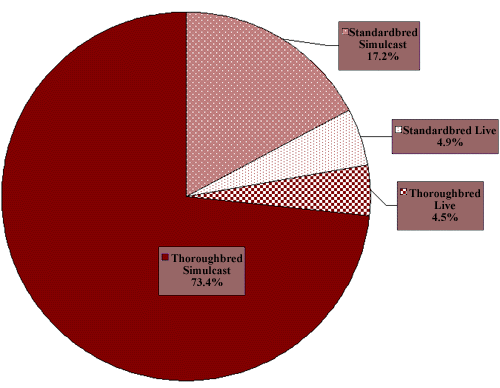
| Breed | Live Handle * | % | Simulcast handle | % | Total Handle | % |
| Standardbred | $7,359,881 | 4.9 | $25,598,272 | 17.2 | $32,958,153 | 22.1 |
| Thoroughbred | $6,737,205 | 4.5 | $109,622,047 | 73.4 | $116,359,252 | 77.9 |
| Combined Breeds | $14,097,086 | 9.4 | $135,220,319 | 90.6 | $149,317,405 | 100.0 |
* Corrected May 2002 from printed version.
The handle above represents all money wagered at all Indiana locations.
Breakdown of Handle by Location
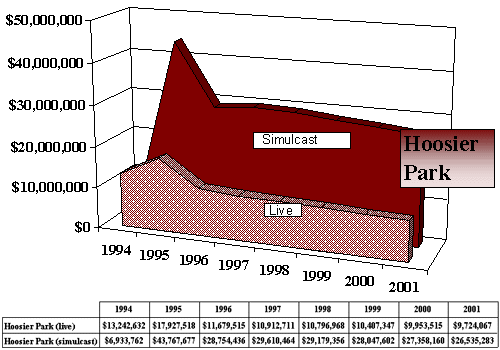
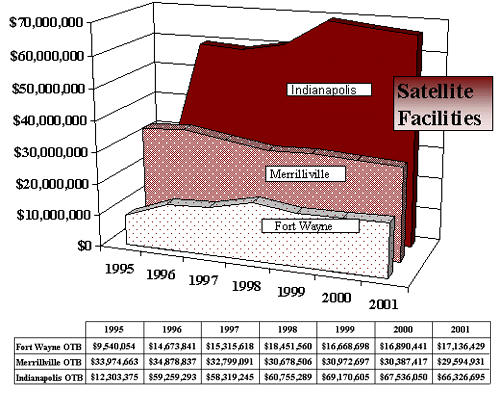
Simulcast Handle - Hoosier Park as Host Track
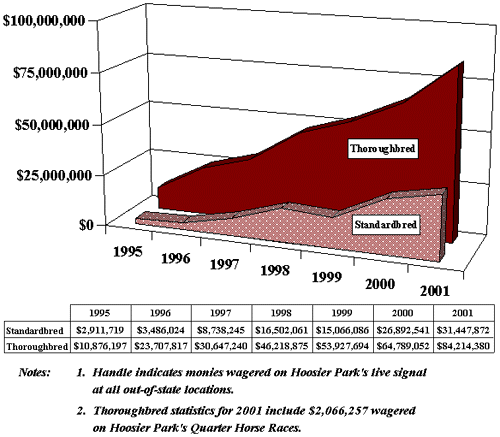
Simulcast Handle - Hoosier Park as Receiving Track
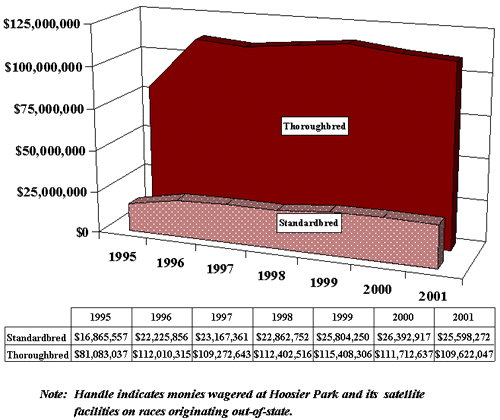
Purses Earned by Type
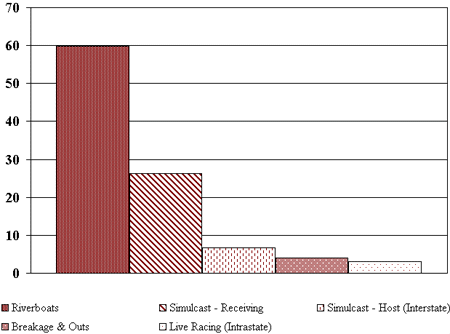
| Type | Amount | % |
| Riverboats (*) | $15,411,720 | 59.9% |
| Simulcast - Receiving | 6,761,016 | 26.3% |
| Simulcast - Host (Interstate) | 1,734,933 | 6.7% |
| Breakage & Outs (*) | 1,046,306 | 4.1% |
| Live Racing (Intrastate) | 777,925 | 3.0% |
| $25,731,900 | 100% |
(*) Assumes 70% of breed development funds are allocated to purses (SB 90% &TB 53%.) Some amounts are approximates.
Purses Paid
Standardbred
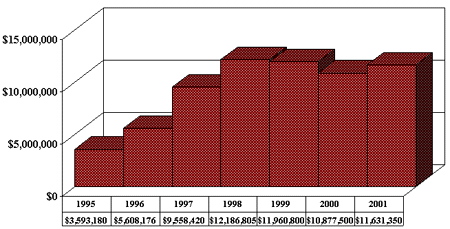
Thoroughbred
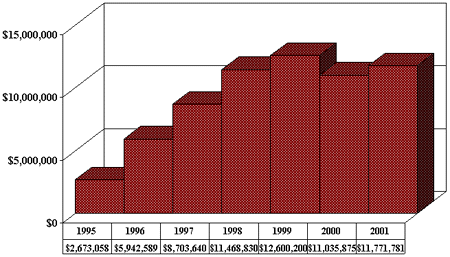
Occupational Licensing
Pursuant to IC 4-31-6 and 71 IAC 5-1-1, all persons participating in pari-mutuel racing under the jurisdiction of the Commission are required to be licensed. The licensing process is the backbone of the Commission's regulatory efforts. Each prospective licensee is fingerprinted. The Federal Bureau of Investigation (FBI) and the Indiana State Police provide the Commission with criminal histories of all applicants. The Commission may refuse or deny the application for licensure of any person who's criminal or racing violation record is contrary to the public's best interest.
| Category | Count | Category | Count | |
| Owner, Standardbred | 1,816 | Asst. Trainer, Standardbred | 38 | |
| Owner, Thoroughbred | 1,687 | Authorized Agent | 35 | |
| Groom | 1,096 | Vendor/Contractor | 35 | |
| Track Employee | 467 | Farrier | 30 | |
| Stable Name | 407 | Owner/Trainer, Quarter Horse | 30 | |
| Owner/Trainer, | 359 | Racing Official | 26 | |
| Trainer, Thoroughbred | 327 | Trainer, Quarter Horse | 23 | |
| Owner/Trainer/Driver | 309 | Pony Rider | 22 | |
| Owner/Trainer, Standardbred | 182 | Jockey Agent | 21 | |
| Pari-Mutuel Clerk | 179 | Apprentice Jockey | 18 | |
| Driver/Trainer | 163 | Gate Crew | 15 | |
| Trainer, Standardbred | 123 | Veterinarian | 12 | |
| Jockey | 118 | Valet | 11 | |
| Driver | 118 | Vet. Assistant | 9 | |
| Vendor Employee | 117 | Track Management | 8 | |
| Asst. Trainer, Thoroughbred | 101 | Other | 8 | |
| Owner, Quarter Horse | 95 | Farrier's Assistant | 4 | |
| Track Security | 80 | Asst. Trainer, Quarter Horse | 1 | |
| Exercise Rider | 51 | Outrider | 1 | |
| Commission Staff | 48 | Stable Employee - Stbrd | 1 |
| Total Licenses Issued | 8,191 |
| 1994 | 1995 | 1996 | 1997 | 1998 | 1999 | 2000 | 2001 | |
| Licenses Issued | 1,922 | 5,269 | 6,292 | 7,152 | 7,806 | 7,877 | 7,808 | 8,191 |
| Probationary Licenses Issued | 21 | 54 | 53 | 68 | 80 | 70 | 89 | 113 |
| Licenses Refused | 16 | 10 | 29 | 26 | 21 | 21 | 9 | 16 |
Equine Drug Testing
Pari-mutuel horse racing can succeed as a legitimate major league sport only if its races are perceived by the wagering public to be honest, competitive contests, free from manipulation by man or drugs. With the exception of furosemide (salix) and phenylbutazone (bute), under regulatory restrictions, state law and Commission rules prohibit the presence of any drug in horses racing at a pari-mutuel track. The Commission's drug detection program is one of the nation's most comprehensive and its laboratory, one of the most respected in the racing industry.
Truesdail Laboratory in Tustin, California, serves as the primary testing laboratory for the Indiana Horse Racing Commission. Truesdail Lab has been a leader in racing chemistry and drug-related research for over 50 years. The following table indicates, by breed, the number of samples analyzed and the number of positive tests reported. In each instance, the offending horse was disqualified and placed last. In accordance with the pari-mutuel statute, all purse money earned is ordered returned and redistributed.
| Breed | Race Dates | Urine | Blood | Positive Tests |
| Standardbred | 123 | 2143 | 2515 | 2 |
| Thoroughbred | 70 | 1479 | 1559 | 13 |
| Totals | 193 | 3622 | 4074 | 15 |
The table below represents a further breakdown, by breed, of the name and types of drugs reported by the laboratory.
| Standardbred | Thoroughbred | Drug Classification | Type |
| 4 | Banamine (Class 4) | non-steroidal anti-inflammatory | |
| 1 | Prednisolone (Class 4) | corticosteroid | |
| 2 | 7 | Bute (Overage) | non-steroidal anti-inflammatory |
| 1 | Salix (Overage) | diuretic | |
Human Drug Testing
Commission regulations provide that a licensee or an applicant for licensure may be required, if reasonable suspicion exists, to submit to a drug test. Commission rules require a minimum suspension of thirty (30) days for a positive test for an illegal drug.
| Human Drug Testing | 1994 | 1995 | 1996 | 1997 | 1998 | 1999 | 2000 | 2001 |
| Number of Samples Tested | 1 | 14 | 15 | 33 | 24 | 32 | 16 | 18 |
| Number of Positive Tests | 0 | 3 | 8 | 14 | 12 | 19 | 6 | 9 |
Breed Development Programs - Standardbred
Overview
Pursuant to IC 4-31-11, breed development funds have been established to promote the breeding of horses while stimulating the agri-business sector of the state's economy. All breakage and unclaimed winning tickets are statutorily earmarked for breed development. In addition, twenty percent (20%) of the riverboat admission tax allocated to the racing industry is distributed to breed development funds. Standardbred and thoroughbred breed development advisory committees make recommendations to the Commission regarding the distribution of these monies.
Standardbred
The Standardbred Breed Development Program continued with a lucrative program at Hoosier Park in 2001that included a series of Late Closing events, the GENESIS Series and the Indiana Sires Stakes. Indiana Sired Late Closing events, Indiana Sires Stakes, Indiana sired overnights, GENESIS Series, and the Indiana Sired Mini Series awarded $4,273,577 in purse money. The Breed Development program has provided an opportunity for the Indiana Sires Stakes to become one of the industry's premier programs. The Indiana Sires Stakes program reached record levels for 2001, with finals for three year olds growing above $100,000, and the program awarding $1,852,220 in purses to Indiana Sired horses. The success of the Indiana Standardbred Breed Development Program during 2001 has resulted in over 5.4 million dollars paid in purses at Hoosier Park to Indiana Sired horses and premium prices received for Indiana sired yearlings at the Indiana sales. More than 1,907 broodmares were bred to registered Indiana stallions in 2001, assuring continuous growth of our state's Standardbred industry.
The successful Indiana Sired Fair Circuit Program was continued for the county and state fair. During 2001, a two-tier racing system was successfully implemented into this program, giving horses more racing option at the county fair level. This two-tier racing system was also continued into the "Fall Classic Racing Program" which in its third year, gave Indiana sired horses an opportunity to race after the completion of the Indiana State Fair and Hoosier Park. Owners of Indiana sired horses winning in open company at Hoosier Park received a bonus award. Breeder awards were made to the breeders of the winning Indiana sired horses of the finals and legs of the Sires Stakes, the finals of the Indiana sired Late Closing Events, and the winners of the Indiana Sired Fair Circuit Championship race. Through these continued efforts, the Standardbred Breed Development Program is developing and promoting a fast growing and high quality Standardbred industry in the state of Indiana.
| Purse supplements - Hoosier Park | $1,896,600 |
| Purse supplements - County Fairs | 373,750 |
| Purse supplements - State Fair | 340,000 |
| Purse supplements - Fall Classic | 165,440 |
| Indiana Sired & Breeder Awards | 340,506 |
| Total | $3,116,296 |
Breed Development Programs - Thoroughbred
The mission of the Thoroughbred Development Advisory Committee is to register thoroughbred horses for the Indiana bred program and provide incentives and awards to three important elements of the Indiana thoroughbred industry: the owner, the breeder and the stallion owner. The intent of these incentives and awards is to promote investment of capital into the Indiana economy (via thoroughbred breeding, racing and related agri-business) and maximize the positive impact to the state's economy. The incentives reward risk, and the awards reward success on the racetrack…through winning!
The Indiana bred program is funded by the Breed Development Fund established in the Indiana pari-mutuel statute. The Breed Development Fund consists of breakage (the difference in the rounding off of pari-mutuel payoffs), outs (all uncashed tickets), and the riverboat admissions tax allocation. The Indiana Horse Racing Commission receives 65 cents for every admission on an Indiana riverboat. Twenty (20) percent of the 65 cents goes into the Breed Development Fund. The Breed Development Fund is divided equally, fifty (50) percent to the Indiana Thoroughbred Development Fund and fifty (50) percent to the Standardbred Breed Development Fund.
| Purse Supplements | $ 1,348,000 |
| Owners Awards | 1,254,100 |
| Breeders Awards | 1,037,625 |
| Stallion Owner Awards | 77,200 |
| Out-of-State Awards | 45,560 |
| Total | $3,762,485 |
2001 Breed Development Fund Revenue
| Breed | Breakage | Outstanding Tickets * | Riverboat Revenue | Total |
| Standardbred | 393,042.42 | 354,319.88 | 3,153,906.95 | 3,901,269.25 |
| Thoroughbred | 393,042.42 | 354,319.87 | 3,153,906.95 | 3,901,269.24 |
| Quarter Horse | N/A | N/A | 100,000.00 | 100,000.00 |
| Total | 786,084.84 | 708,639.75 | 6,407,813.90 | 7,902,538.49 |
* Outstanding ticket revenue is based on tickets purchased in 2000 which expired in 2001
Blood Gas Analysis Program
The purpose of the Blood Gas Analysis (BGA) program is to deter and detect the practice of "bicarbonate loading" or what is known in the racing business as "milkshaking." This practice generally entails giving a horse a large quantity of an alkaline substance, usually baking soda, prior to a race. The alkaline substance neutralizes the lactic acid that is produced during exercise and, as a consequence, delays the onset of fatigue. Research has demonstrated that this practice induces some horses to race faster times. Bicarbonate loading can give a horse an unfair competitive edge and thus compromise the integrity of the sport. This practice is strictly prohibited by the rules of the Commission.
The BGA Program is operated by the Commission in a small laboratory located in the paddock at Hoosier Park. Blood samples of selected horses are analyzed prior to the race on a state-of-the-art blood gas analysis machine. Each sample is analyzed by a certified lab technician under contract through St. John's Hospital in Anderson.
Riverboat Revenue
The statute permitting riverboat gaming in Indiana earmarks sixty-five (65) cents of the three dollar admission tax to the pari-mutuel horse racing industry. These funds are distributed to various segments of the racing industry in accordance with Commission rule 71 IAC 12-2-15.
From Admission Tax (65 cents)
| Purses | $10,926,251.12 | |
| $5,363,125.56 | ||
| 5,363,125.56 | ||
| 200,000.00 | ||
| Track | 6,800,000.00 | |
| Breed Development | 6,407,813.90 | |
| $3,153,906.95 | ||
| 3,153,906.95 | ||
| 100,000.00 | ||
| Promotion Fund | 2,681,562.77 | |
| Total | $26,815,627.79 |
Distribution Formula: Pursuant to 71 IAC 12-2-15, riverboat revenue is allotted 40% to purses, 30% to the track, 20% to breed development and 10% to a track promotional fund. A cap of $6.8 million is placed on a permit holder. The overage from the $6.8 million dollar cap imposed upon Hoosier Park in 2001 amounted to $1,244,688.32. This amount has been allocated pursuant to 71 IAC 12-2-15 as follows (1) $200,000 to Quarter Horse purses; (2) $100,000 to Quarter Horse Breed Development; (3) $472,344.16 to Standardbred Breed Development and (4) $472,344.16 to Thoroughbred Breed Development.
